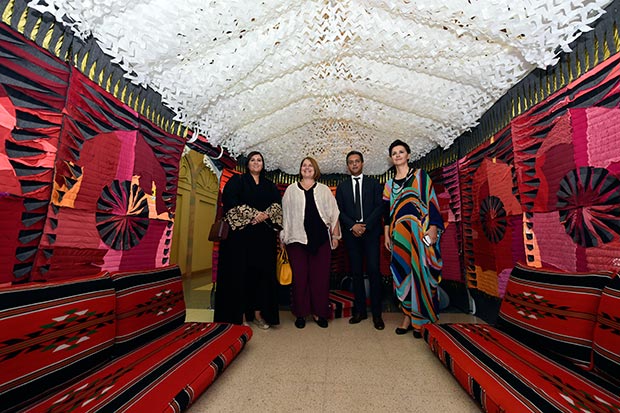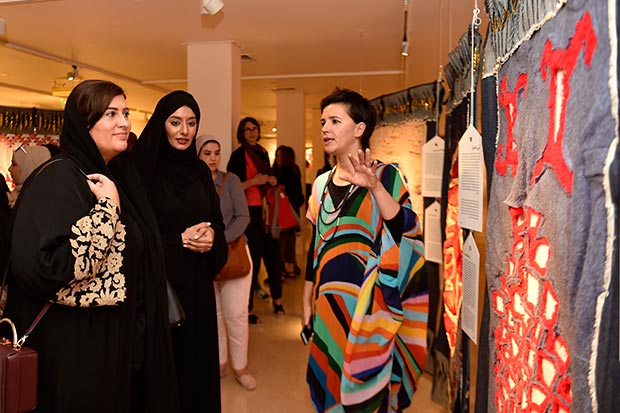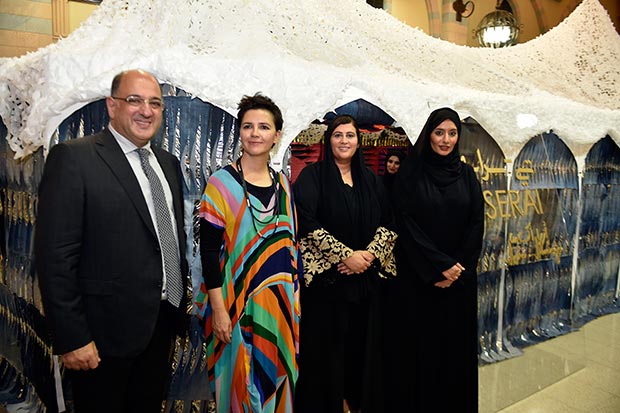
EXHIBITION AT THE SHARJAH MUSEUM OF ISLAMIC CIVILIZATION (Sep 25 - Dec 7, 2019) Textile Installation T-Serai Highlights Humanitarian Causes
Nov 14, 2019 INSPO, Exhibition

Held under the patronage of His Highness Sheikh Dr. Sultan bin Mohammad Al Qasimi, Supreme Council Member and Ruler of Sharjah, the ‘T-Serai' exhibition, was inaugurated by Manal Ataya, Director-General of Sharjah Museums Authority (SMA) in the presence of HE Dr. Dena Assaf, United Nations Resident Coordinator for UAE; Reem Bin Karam – Director of the NAMA Women Advancement Establishment; and Dr Zaki Aslan, Regional Representative of ICCROM for the Arab States and Director of ICCROM-Sharjah.
 Dr. Azra Aksamija presents her work at the opening / Courtesy of Sharjah Museums Authority (SMA)
Dr. Azra Aksamija presents her work at the opening / Courtesy of Sharjah Museums Authority (SMA)
Dr. Azra Aksamija, a Bosnian artist and architectural historian, director of the Future Heritage Lab (FHL) and Associate Professor at the Massachusetts Institute of Technology, produced the four-metre-high “portable palace†from recycled fabrics. She developed it with the support of SMA, and various international humanitarian and cultural institutions, and with a team from FHL, involving collaborations with students and refugee learners across the USA, Europe, and the MENA region.
The textile installation addresses the cultural, educational, and emotional needs of refugees and also raises awareness about the social and environmental cost of people’s consumer lifestyles. 'T-Serai' stands for the 'Textile Systems for Engagement and Research in Alternative Impact,' an acronym for a culturally sensitive approach to a humanitarian aid involving textile arts and crafts. The exhibition title also alludes to the name of the standardized humanitarian T-Shelters, made of corrugated steel. It also references histories of the textile architecture of the MENA region, especially the Ottoman portable palaces, and the living tradition of the khayamiya. The tent is made of modular tapestries, using recycled clothes sewn in a reverse appli-qué technique, which can be used by refugees to share their personal stories to preserve their cultural memory.
 Dr. Azra Aksamija with Manal Ataya, and esteemed guests / Courtesy of Sharjah Museums Authority (SMA)
Dr. Azra Aksamija with Manal Ataya, and esteemed guests / Courtesy of Sharjah Museums Authority (SMA)
“SMA’s support for this impactful work that conveys a strong message, arises from our belief that cultural institutions including museums play a key role in providing re-sources for artists and academics to conduct research that would help facilitate producing and disseminating new information and new perspectives on important global concerns,†said Manal Ataya.
Ataya stressed that museums and cultural institutions need to contribute more actively in showcasing artworks that highlight pressing current issues whether environmental, political or social concerns.
"We as museums can assist artists and individuals working in this field to help communities rethink and learn about these concerns in a way that encourages discussions and most importantly encourages action,†said Ataya.
 Dr. Azra Aksamija presents her work at the opening / Courtesy of Sharjah Museums Authority (SMA)
Dr. Azra Aksamija presents her work at the opening / Courtesy of Sharjah Museums Authority (SMA)
Dr. Azra Aksamija explained, "T-Serai exhibition also includes FHL’s research about design inventions created by displaced Syrians in Al Azraq Refugee Camp in Jordan. These inventions highlight the social, cultural, and environmental responsibility of design to address the 'real needs' of people who have lost their home, history, and identity.â€
She pointed that refugees’ inventions can teach others how to rethink humanitarian aid, to approach refugee assistance, not just by providing makeshift shelters, but by creating civic spaces where crucial social healing, innovation, creativity, and cross-cultural interactions can take place.
“As an educator and an artist, I am trying to find how I can be most impactful, to inspire people and bring them together to co-create art and deconstruct boundaries,†she said.
 Dr. Azra Aksamija with Manal Ataya, and esteemed guests / Courtesy of Sharjah Museums Authority (SMA)
Dr. Azra Aksamija with Manal Ataya, and esteemed guests / Courtesy of Sharjah Museums Authority (SMA)
“Maybe this will impact the way in which humanitarian aid is planned so that to consider more cultural and emotional needs of displaced people by being informed through their voices. Parallel productions of T-Serai tapestries will later take place at Al Zaatari Refugee Camp in Jordan, said Azra adding that her collaboration with SMA is due to her belief in their efforts in connecting different cultures, and establishing an open human dialogue. Through art, history and science, museums attract different audiences allowing us to build bridges and connect diverse people across borders,†said the artist.
The exhibition is on view until December 7, 2019 at Sharjah Museum for Islamic Civili-zation (SMIC).
Comments
Add a comment